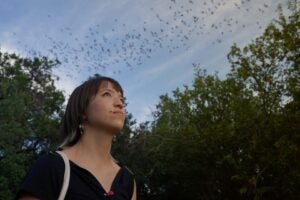AUSTIN, Texas —They look no more significant than bits of popcorn tossed into a finger bowl. But the small balls of cotton floating in a petri dish in the laboratory of Dr. R. Malcolm Brown Jr. could hold the key to increased profits for a major Texas industry.
Brown, holder of the Johnson & Johnson Centennial Chair in Plant Cell Biology, and his graduate student, Rong Feng, have developed a novel method for growing cotton fibers in submerged cell culture, which means they are growing plant cells away from the mother plant using liquid filled with special nutrients.
Research by these biologists at The University of Texas at Austin could pave the way for development of stronger, better textiles and specialty cotton products, a potential boon for the $1.2 billion-a-year cotton industry in Texas. The Texas Agricultural Extension Service estimates the total economic impact of cotton in Texas is $2.3 billion.
Their research is supported by a grant from the Texas Food and Fiber Commission. Brown is a professor in the section of molecular genetics and microbiology at UT Austin’s College of Natural Sciences. Rong, a native of the northwestern Chinese province of Shanxi, worked in genetic breeding and tissue research at a cotton research institute in China for six years before coming to study in the United States.
Brown explained that previously, cotton fibers only could be produced in culture by floating the ovules (or seed) on the surface of a liquid medium. If the ovules sank, fiber production ceased. The new method involves actually submerging the seeds in the liquid, which produces fibers very similar to those grown on the living plant.
Brown said he hopes that some day it will be possible to produce a fiber product that has better quality and more diverse traits for yarn and textile production. Brown said the new submerged ovule culture technique has the potential to show researchers how the cellulose walls of cotton fibers could be made stronger.
Fibers grown in submerged culture often are smaller in diameter and have thicker cell walls. The result is the laboratory production of cotton fibers that may have unique traits worthy of further investigation.
“Some of these fibers grown in submerged culture have characteristic helical thickenings of secondary cell walls. These patterns are more like those found in the xylem elements of woody plants,” Brown said.
Brown said such cells might have important new properties such as greater strength, greater plasticity and could have the potential to alter and improve textiles and specialty cotton products, with major implications for the Texas economy.
“If scientists can experimentally alter the dimensions of the cotton fiber as well as cellulose biosynthesis, it should be possible to alter its strength and thus change the way cotton can be handled,” Brown said. Brown said this also would be important for yarn and textile production.
“Using the submerged cotton ovule technique, we have the ability to investigate how the world’s finest cotton is produced. Submerged fibers can give us clues for using genetic engineering to alter or improve fiber traits important in producing yarn and textiles,” Brown said.
Brown said the concept is still in its infancy. Scientists need to do more research at the cellular and molecular levels to understand what causes cotton cellulose to develop the unique properties that make it favorable for textile production and use. “With the submerged fiber technique, we can begin to develop a new understanding of how cotton fiber grows. The submerged cotton fiber culture will provide the first direct clues to learning more about this dynamic process,” Brown said.
A manuscript detailing the research was published in September in the journal titled In Vitro Cellular and Developmental Biology,which ranks among the top 30 percent of cell biology journals. Brown also recently presented the results of this work at the 2000 World Congress of In Vitro Biology in San Diego.
The Brown laboratory is a pioneering facility in the discovery of the genes and enzymes involving cellulose biosynthesis. The submerged culture method developed by Brown and Rong allow continuous monitoring of the growth process using some of the world’s best optical microscopes and advanced image processing technology, yielding an unprecedented method for learning more about the dynamics of cell growth, Brown said.
The scientists have produced dramatic time-lapse videos showing cellular movements within the cotton fibers, views of the growth process never before seen. Their research is continuing into the molecular basis for the way the cotton fibers sprout when they are submerged in the culture.
For more information, contact Dr. R. Malcolm Brown Jr. at (512) 471-3364, visit his Website at http://www.botany.utexas.edu/facstaff/facpages/mbrown/ or e-mail rmbrown@mail.utexas.edu For colorful images of cotton fiber, contact Marsha Miller at (512) 471-3151. Quicktime movies of cotton fiber growth are available at www.botany.utexas.edu/facstaff/facpages/mbrown/rongc7b.avi and www.botany.utexas.edu/facstaff/facpages/mbrown/rong5.avi
For more information about the 2000 World Congress of In Vitro Biology, visit the Website at http://www.sivb.org/



